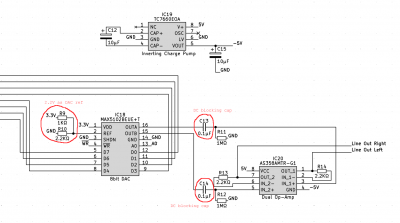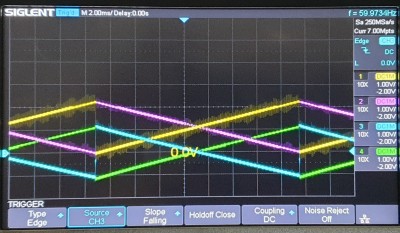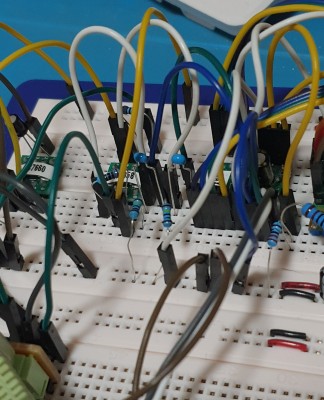GARTHWILSON wrote:
For getting the output centered around 0V, all you need is a series DC-blocking capacitor. The value will depend on the load. If the load itself doesn't bleed the capacitor down, a bleed resistor from output to ground will do the job.
That's perfect thanks! In the end I used a 0.1μF MLCC cap (because it's the smallest I have but I suspect smaller would be fine
[EDIT] - a 0.01μF MLCC cap was not fine). And I also needed a 1MΩ bleed resistor, anything smaller caused the signal to 'warp'.
I changed the DACs reference voltage from 3.3V to 2.2V and that gave me a suitably scaled analogue output signal.
However plugging the output into my amplifiers
Line In dragged it's voltage to zero. I tried a bigger DC-blocking cap and another MΩ resistor in series after it but that just gave me a rounded signal that still went to zero when plugged into the amp.
In the end I brought the op-amp back again and used it to buffer my signal giving me a final schematic:
Attachment:
 Audio DAC schematic.png [ 67.12 KiB | Viewed 194030 times ]
Audio DAC schematic.png [ 67.12 KiB | Viewed 194030 times ]
and a signal (into the speaker amplifier) of:
Attachment:
 Audio DAC waveform.jpg [ 1.39 MiB | Viewed 194030 times ]
Audio DAC waveform.jpg [ 1.39 MiB | Viewed 194030 times ]
The blue and green traces are the level shifted outputs and seem to remain pretty stably centered around 0V.
BillO wrote:
Here is sort of what you need: ... Of course! But I did say "sort of"

Thanks BillO! In the end I just poked roughly valued components in until I got a decent signal

(Oh, the oscilloscope is not drawing the vertical saw tooth line nicely because I left the scope in 'dotty persistent' mode rather than line mode.)
And no post is complete without the messy breadboard, the MAX5102 is hidden behind the mass of jumpers on the right
Attachment:
 Audo DAC boad.jpg [ 1.18 MiB | Viewed 194030 times ]
Audo DAC boad.jpg [ 1.18 MiB | Viewed 194030 times ]







